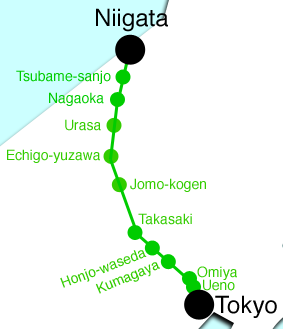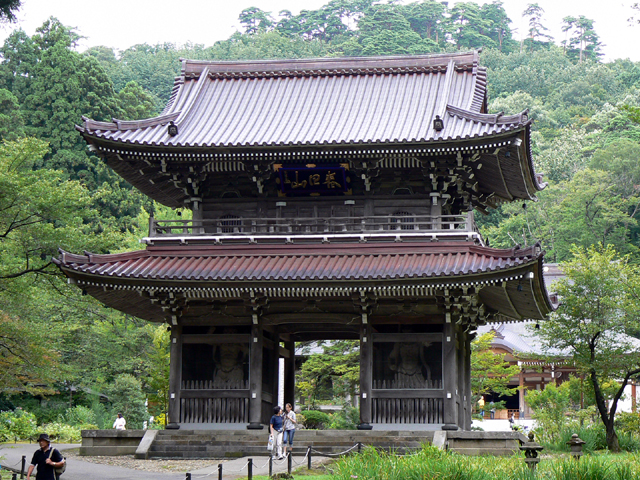|
Daishimizu Tunnel
The is a railway tunnel on the Jōetsu Shinkansen on the border of Gunma Prefecture and Niigata Prefecture, Japan. In 1978, the Dai-Shimizu tunnel was completed. This tunnel was dug for the Jōetsu Shinkansen that was to be completed in 1982. This tunnel was the world's longest railway tunnel at until the Seikan Tunnel was built. During the construction, a fire created a large amount of smoke in the tunnel, and 16 workers died from carbon monoxide poisoning. When this tunnel was completed, the travel time between Niigata and Tokyo went down to approximately one hour and forty minutes, three hours faster than using the Jōetsu Line The is a major railway line in Japan, owned by the East Japan Railway Company (JR East). It connects Takasaki Station in Gunma Prefecture with Miyauchi Station in Niigata Prefecture, linking the northwestern Kanto region and the Sea of Japan .... Also, when this tunnel was built, natural water was found during construction, which is now sold ... [...More Info...] [...Related Items...] OR: [Wikipedia] [Google] [Baidu] |
Jōetsu Shinkansen
The is a high-speed shinkansen railway line connecting Tokyo and Niigata, Japan, via the Tōhoku Shinkansen, operated by the East Japan Railway Company (JR East). Despite its name, the line does not pass through the city of Joetsu or the historical Jōetsu region, which instead are served by the Hokuriku Shinkansen. The name instead originates from the parallel Jōetsu Line, which in turn is named after the two provinces that it connects: Jōshū (an alternate name for Kōzuke Province which comprises today's Gunma Prefecture), and Echigo Province (modern day Niigata Prefecture). Train services * '' Toki'', Tokyo - Niigata (limited-stop) * '' Tanigawa'', Tokyo - Echigo-Yuzawa (all-stations, since October 1997) Discontinued services * ''Asahi'', Tokyo - Niigata (discontinued December 2002) * '' Max Asahi'', Tokyo - Niigata (discontinued December 2002) * '' Max Toki'', Tokyo - Niigata (discontinued October 2021) * '' Max Tanigawa'', Tokyo - Echigo-Yuzawa (discontinued October ... [...More Info...] [...Related Items...] OR: [Wikipedia] [Google] [Baidu] |
Gunma Prefecture
is a prefecture of Japan located in the Kantō region of Honshu. Gunma Prefecture has a population of 1,937,626 (1 October 2019) and has a geographic area of 6,362 km2 (2,456 sq mi). Gunma Prefecture borders Niigata Prefecture and Fukushima Prefecture to the north, Nagano Prefecture to the southwest, Saitama Prefecture to the south, and Tochigi Prefecture to the east. Maebashi is the capital and Takasaki is the largest city of Gunma Prefecture, with other major cities including Ōta, Isesaki, and Kiryū. Gunma Prefecture is one of only eight landlocked prefectures, located on the northwestern corner of the Kantō Plain with 14% of its total land being designated as natural parks. History The ancient province of Gunma was a center of horse breeding and trading activities for the newly immigrated continental peoples. The arrival of horses and the remains of horse tackle coincides with the arrival of a large migration from the mainland. From this point forward, the hor ... [...More Info...] [...Related Items...] OR: [Wikipedia] [Google] [Baidu] |
Niigata Prefecture
is a Prefectures of Japan, prefecture in the Chūbu region of Honshu of Japan. Niigata Prefecture has a population of 2,227,496 (1 July 2019) and is the List of Japanese prefectures by area, fifth-largest prefecture of Japan by geographic area at . Niigata Prefecture borders Toyama Prefecture and Nagano Prefecture to the southwest, Gunma Prefecture to the south, Fukushima Prefecture to the east, and Yamagata Prefecture to the northeast. Niigata, Niigata, Niigata is the capital and largest city of Niigata Prefecture, with other major cities including Nagaoka, Niigata, Nagaoka, Jōetsu, Niigata, Jōetsu, and Sanjō, Niigata, Sanjō. Niigata Prefecture contains the Niigata Major Metropolitan Area centered on Niigata with a population of 1,395,612, the largest metropolitan area on the Sea of Japan coast and the twelfth-largest in Japan. Niigata Prefecture is part of the historic Hokuriku region and features Sado, Niigata, Sado Island, the sixth largest island of Japan in area follo ... [...More Info...] [...Related Items...] OR: [Wikipedia] [Google] [Baidu] |
List Of Longest Tunnels
This list of longest tunnels ranks tunnels that are at least long. Only continuous tunnels are included. Pipelines, even those that are buried, are excluded. The longest tunnels have been constructed for water distribution, followed by tunnels for railways. __TOC__ World's longest tunnels (in use) World's longest tunnels (under construction) World's longest tunnels (advanced planning stage) World's longest tunnels (abandoned) See also * List of long tunnels by type – contains separate tables for railroad, subway, vehicular, bicycle, water/aquaducts, and also for different building techniques * List of deepest caves * List of deepest mines * Lists of tunnels *List of longest railway tunnels ** List of long railway tunnels in China * List of longest subway tunnel sections * List of longest bridges Notes References {{Portal bar, Transport *Length Tunnels Tunnels Tunnels A tunnel is an underground passageway, dug through surrounding soil, earth or roc ... [...More Info...] [...Related Items...] OR: [Wikipedia] [Google] [Baidu] |
Seikan Tunnel
The Seikan Tunnel ( ja, 青函トンネル, or , ), is a dual-gauge railway tunnel in Japan, with a portion under the seabed of the Tsugaru Strait, which separates Aomori Prefecture on the main Japanese island of Honshu from the northern island of Hokkaido. The track level is about below the seabed and below sea level. The tunnel is part of the standard-gauge Hokkaido Shinkansen and the narrow-gauge Kaikyō Line of the Hokkaido Railway Company (JR Hokkaido)'s Tsugaru-Kaikyō Line. The name ''Seikan'' comes from combining the ''on'yomi'' readings of the first characters of , the nearest major city on the Honshu side of the strait, and , the nearest major city on the Hokkaido side. The Seikan Tunnel is the world's longest undersea tunnel by overall length (the Channel Tunnel, while shorter, has a longer undersea segment). It is also the second-deepest transport tunnel below the sea level after the Ryfylke Tunnel, a road tunnel in Norway which opened in 2019, and the second l ... [...More Info...] [...Related Items...] OR: [Wikipedia] [Google] [Baidu] |
Carbon Monoxide Poisoning
Carbon monoxide poisoning typically occurs from breathing in carbon monoxide (CO) at excessive levels. Symptoms are often described as "flu-like" and commonly include headache, dizziness, weakness, vomiting, chest pain, and confusion. Large exposures can result in loss of consciousness, arrhythmias, seizures, or death. The classically described "cherry red skin" rarely occurs. Long-term complications may include chronic fatigue, trouble with memory, and movement problems. CO is a colorless and odorless gas which is initially non-irritating. It is produced during incomplete burning of organic matter. This can occur from motor vehicles, heaters, or cooking equipment that run on carbon-based fuels. Carbon monoxide primarily causes adverse effects by combining with hemoglobin to form carboxyhemoglobin (HbCO) preventing the blood from carrying oxygen and expelling carbon dioxide as carbaminohemoglobin. Additionally, many other hemoproteins such as myoglobin, Cytochrome P450, and ... [...More Info...] [...Related Items...] OR: [Wikipedia] [Google] [Baidu] |
Jōetsu Line
The is a major railway line in Japan, owned by the East Japan Railway Company (JR East). It connects Takasaki Station in Gunma Prefecture with Miyauchi Station in Niigata Prefecture, linking the northwestern Kanto region and the Sea of Japan coast of the Chūbu region. The name refers to the old provinces of Kōzuke (上野) and Echigo (越後), which the line connects. Services Before the opening of the Jōetsu Shinkansen in 1982, the Joetsu Line had frequent service by express trains connecting Tokyo and Niigata. With the opening of the Jōetsu Shinkansen, however, the line became dominated by local and freight trains. The branch of the Jōetsu Shinkansen between Echigo-Yuzawa Station and Gala-Yuzawa Station (the Gala-Yuzawa Line) technically belongs to the Joetsu Line. Stations Rolling stock Present Local Takasaki to Minakami * 211-3000 series 4- and 6-car EMUs (since August 2016) Minakami to Nagaoka * E129 series 2/4-car EMUs (since November 2015) Takasaki to S ... [...More Info...] [...Related Items...] OR: [Wikipedia] [Google] [Baidu] |
Spring Water
A spring is a point of exit at which groundwater from an aquifer flows out on top of Earth's crust (pedosphere) and becomes surface water. It is a component of the hydrosphere. Springs have long been important for humans as a source of fresh water, especially in arid regions which have relatively little annual rainfall. Springs are driven out onto the surface by various natural forces, such as gravity and hydrostatic pressure. Their yield varies widely from a volumetric flow rate of nearly zero to more than for the biggest springs. Formation Springs are formed when groundwater flows onto the surface. This typically happens when the groundwater table reaches above the surface level. Springs may also be formed as a result of karst topography, aquifers, or volcanic activity. Springs also have been observed on the ocean floor, spewing hot water directly into the ocean. Springs formed as a result of karst topography create karst springs, in which ground water travels through ... [...More Info...] [...Related Items...] OR: [Wikipedia] [Google] [Baidu] |
Simplon Tunnel
, it, Galleria del Sempione , line = Simplon line, (Lötschberg railway line) , location = Traversing the Lepontine Alps between Switzerland and Italy , coordinates = – , system = Swiss Federal Railways (SBB CFF FFS) , status = , crosses = Lepontine Alps (Wasenhorn massif) , start = Brig, canton of Valais, Switzerland , end = Iselle di Trasquera, Piedmont, Italy , stations = , startwork = 22 November 1898 (east tunnel), 1912 (west tunnel) , opened = 19 May 1906 (east tunnel), 1921 (west tunnel) , closed = , owner = SBB CFF FFS , operator = SBB CFF FFS , traffic = Railway , character = Passenger, Freight, Car Transport , vpd = Passenger: 70, Freight: ''unknown'' , length = (east tunnel), (west tunnel) , linelength = , tracklength = , notrack = Two single-track tubes , gauge = , el = since 1 June 1906, 15 kV 16.7 Hz since 2 ... [...More Info...] [...Related Items...] OR: [Wikipedia] [Google] [Baidu] |
Railway Tunnels In Japan
Rail transport (also known as train transport) is a means of transport that transfers passengers and goods on wheeled vehicles running on rails, which are incorporated in tracks. In contrast to road transport, where the vehicles run on a prepared flat surface, rail vehicles (rolling stock) are directionally guided by the tracks on which they run. Tracks usually consist of steel rails, installed on sleepers (ties) set in ballast, on which the rolling stock, usually fitted with metal wheels, moves. Other variations are also possible, such as "slab track", in which the rails are fastened to a concrete foundation resting on a prepared subsurface. Rolling stock in a rail transport system generally encounters lower frictional resistance than rubber-tyred road vehicles, so passenger and freight cars (carriages and wagons) can be coupled into longer trains. The operation is carried out by a railway company, providing transport between train stations or freight customer faciliti ... [...More Info...] [...Related Items...] OR: [Wikipedia] [Google] [Baidu] |
Tunnels Completed In 1982
A tunnel is an underground passageway, dug through surrounding soil, earth or rock, and enclosed except for the entrance and exit, commonly at each end. A pipeline is not a tunnel, though some recent tunnels have used immersed tube construction techniques rather than traditional tunnel boring methods. A tunnel may be for foot or vehicular road traffic, for rail traffic, or for a canal. The central portions of a rapid transit network are usually in the tunnel. Some tunnels are used as sewers or aqueducts to supply water for consumption or for hydroelectric stations. Utility tunnels are used for routing steam, chilled water, electrical power or telecommunication cables, as well as connecting buildings for convenient passage of people and equipment. Secret tunnels are built for military purposes, or by civilians for smuggling of weapons, contraband, or people. Special tunnels, such as wildlife crossings, are built to allow wildlife to cross human-made barriers safely. Tu ... [...More Info...] [...Related Items...] OR: [Wikipedia] [Google] [Baidu] |





.jpg)

.jpg)
